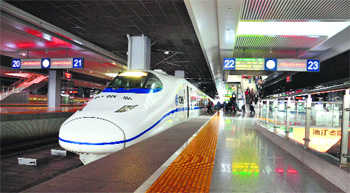Who wouldn’t want to travel from Chandigarh to Delhi in one-hour flat? A flight takes under an hour but the check-in and the wait for luggage on arriving clocks up the actual travel time to four.
The only feasible solution: a Bullet Train. And the day perhaps is not far. India under Narendra Modi has been promised Bullet Trains, an initiative that actually began two years back. The Ahmedabad-Mumbai link has been surveyed and there is also talk of a Delhi-Chandigarh Bullet Train or one to Ludhiana or Amritsar.
While India still ponders, the Chinese have marched ahead. Seven years after the first trial run, China has the world’s most extensive network of Bullet Trains. The best part is that the travel is inexpensive. For a distance of 1,300 km between Beijing and Shanghai (a little less than Amritsar-Ahmedabad), the cost is Rs 3,500 for an airline-type business class seat and Rs 5,500 for an ultra plush one. Five daily trains take under five hours, halting only at the historic city of Nanjing, while a dozen others take an extra 30 minutes because of more stops.
In four minutes, the train touches 136 kmph, the view of the snow-encrusted tracks broadcast on a TV screen from an engine-mounted camera. Five minutes later, it noiselessly cruises at 287 kmph. Bullet Trains once did touch 400 kmph, but a 2010 crash that killed 40 and also exposed the seamier side of China’s breakneck infrastructure boom led to the maximum speed getting restricted to just over 300 kmph. A two-minute stop at Nanjing, and in five hours passengers are in Shanghai, most of them as fresh as they had boarded.
Planning for the Mumbai-Ahmedabad experience
- High tariff and large passenger volumes are must to justify investment in high-speed trains as these are highly capital intensive in nature
- Railways has selected seven corridors for pre-feasibility studies
- High Speed Rail Corporation (HSRC) will develop these rail corridors for trains at speeds of 350-kmph.
- First bullet train will start from Bandra-Kurla Complex in Mumbai
- Thane will be the first stop, followed by Virar, Palghar, Vapi and Valsad. The train will terminate near Sabarmati in Ahmedabad.
- Will cover 520 km in 3-4 hours, less than half the time taken by Rajdhani.
- 50-100 km: The distance between each station on the line
- Number of stations on thishigh-speed corridor: 7
- Rs 60,000 crore: Approximate costof the project
- Rs 100 crore: Amount budgetedto initiate the project
- Rs 15 crore: Cost for laying a km of tracks for current railway network
- Rs 125 crore: Cost per km for thehigh-speed corridor
- 15,000: Passengers travel between Mumbai-Ahmedabad route daily
- 25: Number of trains on the Mumbai-Ahmedabad route
- Ticket cost: Close to the price of a first-class AC coach
Unlock Exclusive Insights with The Tribune Premium
Take your experience further with Premium access.
Thought-provoking Opinions, Expert Analysis, In-depth Insights and other Member Only Benefits
Already a Member? Sign In Now










